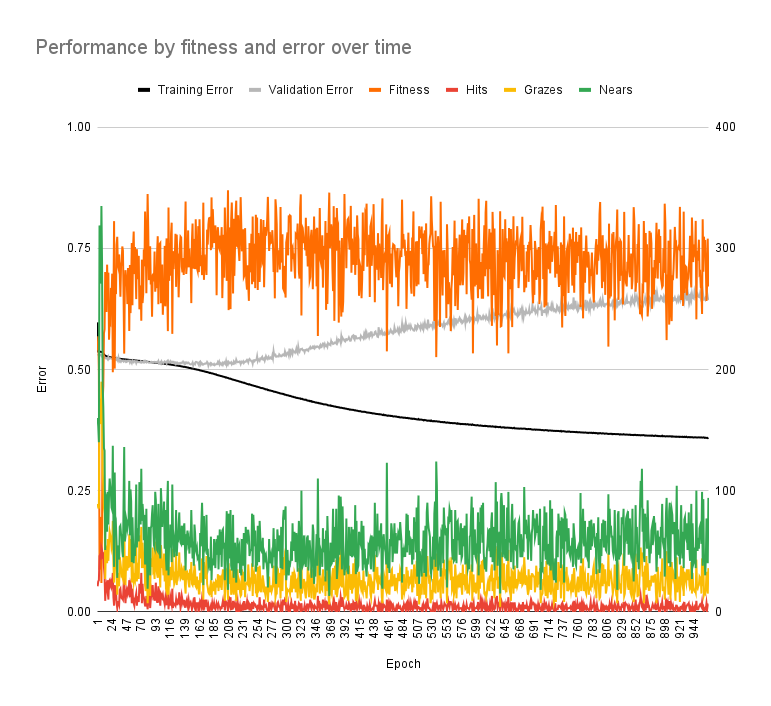- 3 Posts
- 12 Comments

 1·4 months ago
1·4 months agothe training environment is pretty basic right now so all bullets shoot from the top of the screen with no enemy to destroy.
additionally, the program I’m using to get player and bullet data (twinject) doesn’t support enemy detection so the neural network wouldn’t be able to see enemies in an existing bullet hell game. the character used has a wide bullet spread and honing bullets so the neural network inadvertently destroys the enemies on screen.
the time spent in each training session is constant rather than dependent on survival time because the scoring system is based on the total bullet distance only.

 1·4 months ago
1·4 months agodefinitely. usually algorithms are used to calculate the difficulty of a game (eg. in osu!, a rhythm game) so there’s definitely a practical application there

 3·4 months ago
3·4 months agoone problem ive seen with these game ai projects is that you have to constantly tweak it and reset training because it eventually ends up in a loop of bad habits and doesnt progress
you’re correct that this is a recurring problem with a lot of machine learning projects, but this is more a problem with some evolutionary algorithms (simulating evolution to create better-performing neural networks) where the randomness of evolution usually leads to unintended behaviour and an eventual lack of progression, while this project instead uses deep Q-learning.
the neural network is scored based on its total distance between every bullet. so while the neural network doesn’t perform well in-game, it does actually score very good (better than me in most attempts).
so is it even possible to complete such a project with this kind of approach as it seems to take too much time to get anywhere without insane server farms?
the vast majority of these kind of projects - including mine - aren’t created to solve a problem. they just investigate the potential of such an algorithm as a learning experience and for others to learn off of.
the only practical applications for this project would be to replace the “CPU” in 2 player bullet hell games and maybe to automatically gauge a game’s difficulty and programs already exist to play bullet hell games automatically so the application is quite limited.

 7·4 months ago
7·4 months agoI always find it interesting to see how optimization algorithms play games and to see how their habits can change how we would approach the game.
me too! there aren’t many attempts at machine learning in this type of game so I wasn’t really sure what to expect.
Humans would usually try to find the safest area on the screen and leave generous amounts of space in their dodges, whereas the AI here seems happy to make minimal motions and cut dodges as closely as possible.
yeah, the NN did this as well in the training environment. most likely it just doesn’t understand these tactics as well as it could so it’s less aware of (and therefore more comfortable) to make smaller, more riskier dodges.
I also wonder if the AI has any concept of time or ability to predict the future.
this was one of its main weaknesses. the timespan of the input and output data are both 0.1 seconds - meaning it sees 0.1 seconds into the past to perform moves for 0.1 seconds into the future - and that amount of time is only really suitable for quick, last-minute dodges, not complex sequences of moves to dodge several bullets at a time.
If not, I imagine it could get cornered easily if it dodges into an area where all of its escape routes are about to get closed off.
the method used to input data meant it couldn’t see the bounds of the game window so it does frequently corner itself. I am working on a different method that prevents this issue, luckily.

 3·4 months ago
3·4 months agoI did create a music NN and started coding an UNO NN, but apart from that, no

 8·4 months ago
8·4 months agoyeah, the training environment was a basic bullet hell “game” (really just bullets being fired at the player and at random directions) to teach the neural network basic bullet dodging skills

- the white dot with 2 surrounding squares is the player and the red dots are bullets
- the data input from the environment is at the top-left and the confidence levels for each key (green = pressed) are at the bottom-left
- the scoring system is basically the total of all bullet distances

- this was one of the training sessions
- the fitness does improve but stops improving pretty quickly
- the increase in validation error (while training error decreased) is indicated overfitting
- it’s kinda hard to explain here but basically the neural network performs well with the training data it is trained with but doesn’t perform well with training data it isn’t (which it should also be good at)

 45·6 months ago
45·6 months agothis is the ad-free version, which is available with the exact same (if I’m correct) features on F-Droid for free, along with the source code on GitHub.
the versions on the Play Store (paid version and free version with ads) likely just help pay the developer for their work
and as others have said already, free software is free as in freedom, not free beer.

 1·6 months ago
1·6 months agooh, I forgot about the API not being freely available; so an alternate frontend wouldn’t be a proper solution?
going by the other comments, though, there are client-side options that can avoid API issues entirely by just re-styling the webpage. thanks for the info, though!

 1·6 months ago
1·6 months agoyeah, that was the main reason I wanted to apply it to old Reddit specifically, because it would have been easier with simpler theming and old Reddit is close to Lemmy’s style too
I installed RES beforehand, but haven’t used any of its features. I’ll try this out first and maybe Stylish if that doesn’t work. thanks!

 1·6 months ago
1·6 months agookay thanks for the tip! I’m already using Stylish but I couldn’t find a pre-made style for Lemmy.
I figured I could make my own but I didn’t want to waste time doing something that could have been done already or could be done faster. at least I know I’m on the right track!

 1·10 months ago
1·10 months agothis change was made by the Tory government, btw.
here’s the main part of the article copy-pasted (with important parts in bold):
Today, Minister for the Constitution and Devolution Chloe Smith has announced measures to apply the tried and tested system of First Past the Post to the election of council and ‘metro’ mayors across England, and to Police and Crime Commissioners across England and Wales.
In this May’s London Mayoral elections, the Supplementary Vote system saw hundreds of thousands void, wasted or blank votes cast, reflecting voter confusion and the complex system. Supplementary Vote also means that a ‘loser’ candidate can win on second preferences. In 1931, Winston Churchill described transferable voting as “the decision is to be determined by the most worthless votes given for the most worthless candidates.”
First Past the Post is the world’s most widely used electoral system. The change to First Past the Post will further strengthen the accountability of elected mayors and PCCs to their electorate, making it easier for voters to express a clear choice. The person chosen to represent a local area should be the one who directly receives the most votes.
Chloe Smith, Minister for the Constitution, said:
Britain’s long-standing national electoral system of First Past the Post ensures clearer accountability, and allows voters to kick out the politicians who don’t deliver. First Past the Post is fair and simple – the person with the most votes wins.
Kit Malthouse, Minister for Policing, said:
We are strengthening the accountability and role of Police and Crime Commissioners, to help cut crime and deliver on the people’s priorities.
Luke Hall, Minister for Local Government, said:
Elected mayors can provide strong leadership, and must be held to account at the ballot box. The supplementary vote is an anomaly which confuses the public and is out of step with other elections in England, both local and national. Moving to First Past the Post will make it easier for voters to express a clear choice.
edit: added link
currently, yes, but this is more an investigation into how well a neural network could play a bullet hell game
very few bullet hell AI programs rely on machine learning and virtually all of the popular ones use algorithms.
but it is interesting to see how it mimics human behaviour, skills and strategies and how different methods of machine learning perform and why
(plus I understand machine learning more than the theory behind those bullet hell bots.)